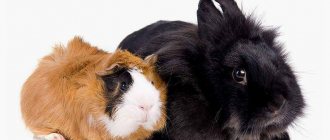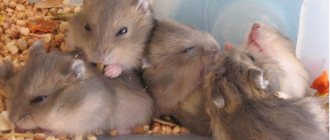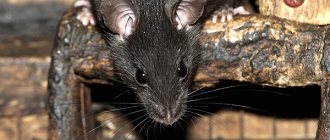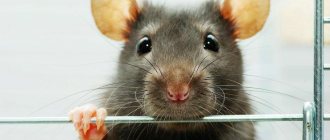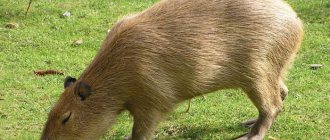Why is it worth buying a rodent for your home?
Any, even the most unpretentious pets at first glance require care: proper nutrition, timely medical care, provision of the “correct” living conditions, education and training. The only question is how much time and finances have to be spent on providing appropriate care.
The dog needs frequent walks. And walking with four-legged pets is not only a pleasant pastime in the fresh air, but also constant washing of paws, examinations for ticks, treatment for minor cuts and other injuries.
In addition, dogs require mandatory training. Yes, yes, even small decorative dogs taken into the home solely “for pleasure” should know the boundaries of what is acceptable and have a clear idea of what is allowed and what is not allowed.
Cats, unlike dogs, do not require obligatory walking and, in general, behave more independently. However, at the same time, many pet owners note the waywardness or even “capriciousness” of their pets.
If a dog is a pack animal and therefore requires constant communication, then cats most often behave like loners. Yes, the cat can climb onto your lap or “ask” for attention, but he will only do this when he wants. Cats carefully respect their personal boundaries. The scars on the hands of their owners are further confirmation of this.
Parrots and other feathered pets do not require as much space as cats and dogs. However, they need almost the same amount of attention. Parrots are sociable guys, which means that they definitely need an “interlocutor.” If you don't have time to play with your pet, you will have to get two birds at once - but in this case you may turn out to be a “third wheel” for them.
The fish are too “asocial” and require special care. Aquarium keeping is a serious hobby, often expensive and requiring certain skills. Before acquiring a “real” aquarium, a beginner will have to get his hands on less demanding pets.
- Top 7 aquarium fish for beginners
Do you dream of aquarium fish, but are you afraid of not being able to cope? Let's talk about the easiest types and breeds to care for.
Turtles , both waterfowl and land ones, require special conditions of detention. Correct levels of humidity and air temperature, absence of drafts, a certain ventilation regime - ensuring all this may not be as simple as it seems at first glance.
At the same time, domestic rodents do not require as much communication as dogs, do not behave as capricious as cats, do not make noise like parrots, and do not require special conditions like fish or turtles.
Do not think that the list of domestic rodents is limited to hamsters and guinea pigs. In reality there are many more. Let's talk about the most popular ones.
Types of the smartest breeds
In the wild, a rat has one body shape, one type of fur, and mostly one color. However, genetic mutations occurred naturally in the domestic animal population and were then selected and bred for them. As a result, pet rats now come in a wide range of coat colors and textures, as well as two ear positions. However, they are all still the same species and can interbreed, but they have different appearances.
The word variety can be used in different ways in the rat world:
- this may refer to whether the coat is smooth or curly,
- what shape are the ears?
- or what color the wool is.
As a result, all rats come from more than one variety - for example, you might have a rex (fur type), a dumbo (ear type), a black (color), and a hooded (marking). The appearance of a rodent does not affect its intelligence in any way.
Rats' mental abilities are not related to fur texture or color, ear shape, or body size. They depend on the nature of a particular rodent. However, there is a theory that females are smarter than males.
Syrian (golden) hamster
Syrian, also known as golden, or Western Asian hamsters are small animals with a length of 13 to 14 cm, of which approximately 1.5 cm is in the tail. Weight – 100-125 g. They are omnivores, in natural conditions they feed on seeds, nuts and some insects (ants, flies, wasps, cockroaches). In captivity they can live up to 3-4 years. The color can be golden, white, black, silver or brown.
A solitary animal that does not require a partner for communication, but easily finds a common language with its owner.
Josephoartigasia
An extinct species of South American rodents that lived during the early and late Pliocene. The rodent received its name in honor of a man named Jose Gervasio Artigas, who became the national hero of Uruguay. It was there that the remains of Josephoartigasia were found in 1981. In Montevideo, scientists discovered a 21-inch skull that was larger than that of a cow. Being the largest rodent of all time, Josephoartigasia lived in the forests of South America. The length of the body reached eight meters, and the weight was 2000 pounds. Most likely, the animals were herbivores, although it is possible that Josephoartigasia could not kill other animals in order to survive. Of the living rodents, Josephoartigasia resembles a large capybara in appearance.
Djungarian hamster
A miniature rodent up to 10 cm long and weighing up to 65 g. Life expectancy is 10-12 months in the wild, and about 2-2.5 years in captivity (some individuals live up to four years). There are several color options - brown-gray (standard), gray-bluish (sapphire), matte white with gray intervals (pearl), red-cream (mandarin).
A distinctive feature is a dark strip of fur along the spine. It is curious that in winter the animals molt, and their fur becomes almost completely white.
They get along well in the same cage with representatives of their species.
Chinese hamster
Chinese hamsters differ from their relatives from the Hamster family by their more elongated body proportions.
Young individuals are not very flexible, but if the animal is often communicated with, it very quickly gets used to being handled and even becomes attached to its owners. At the same time, Chinese hamsters do not get along well with their relatives. This is especially true for males, who have a habit of constantly entering into conflict due to the fact that they cannot divide the territory.
There are three types of color: gray (the so-called wild type), spotted white, white (a rather rare variety). They are known for their speed and resourcefulness, so such pets should be kept in a cage with a small distance between the bars. Some owners even set up a special aquarium for them.
Enemies of the capybara
Although capybaras are quite large animals, there are many predators from which they have to hide. On land, jaguars or feral dogs may be waiting for rodents. From them, capybaras hide in the water, sticking only part of their muzzle to the surface in order to be able to breathe and observe the surroundings. Baby rodents often become prey for urubu vulture birds.
Even being in the water does not always guarantee safety for capybaras. Crocodiles or anacondas may be waiting for them here. People also pose a significant danger to these rodents. Animals are killed for their tasty meat, similar to pork. Nowadays there are many farms where capybaras are bred.
Clawed (Mongolian) gerbil
The gerbil looks like a mouse with a tassel on its tail. They are noticeably different in size from hamsters. Male gerbils can reach a length of 20 cm. It is curious that in captivity, males behave more friendly than females, while females are more active.
In the wild, gerbils live in groups consisting of one male and 2-3 females. Females and males care for the cubs together, however, as soon as the babies grow up, the parents “drive” them away from their territory.
On a note! The best food for gerbils is specially formulated mixtures for rodents. Cabbage, peas, potatoes, sour or too sweet fruits are strictly prohibited. Sometimes protein is added to the diet (egg whites, beetle larvae).
Socialization
Capybaras live in large families of 10-20 individuals each. The main one in this group is the dominant male, who controls other males, females and cubs. About 10% of these rodents live alone. This can happen if the main male drives out another, whom he considers a competitor. In this case, the expelled animal is forced to live independently.
During dry periods or in places where there is a shortage of water, animals may gather in flocks. One such flock can contain several hundred rodents, which occupy an area of 5-10 hectares.
To communicate, they use peculiar whistling, clicking and barking sounds.
Decorative mouse
Decorative mice are, in essence, distant relatives of the well-known house mice (yes, the same ones that have the habit of settling not far from human homes and often “peeping into the light” of country houses in the autumn-winter period).
The only difference between such mice and their wild relatives is their colors - they are not found in nature.
Mice are social animals, so it is best to keep them in pairs or groups consisting of only females. Males will almost certainly not be able to live with each other.
Justified and unfounded fears
More recently, about 3 decades ago, articles appeared in Moscow newspapers about giant rats found in the Moscow metro. The articles claimed that the rats appeared on the surface, where they attacked passersby.
These rats were comparable in size to dogs, and they had red eyes, yellow plaque on their teeth and a wolfish smile. In other words, disgusting and rather aggressive monsters.
With the advent of the Internet, terrifying videos of rodents are increasingly appearing on social media. The Chinese presented a photo of a mouse holding its tail. It is believed to have been the largest mammal of its species, weighing several kilograms.
Thanks to the Internet, many people began to develop phobias, both justified and unfounded, towards this type of rodent. Who wants to meet a giant rat on their way, and a hungry one at that. In fact, not everything is so simple and ambiguous, because there are different types of rats, and there are animals similar to rats.
Domesticated rat
Unlike their wild ancestors, modern domesticated rats are practically not afraid of people and willingly make contact. These are smart animals with a calm and “non-conflict” character.
Like any social creatures, they require constant communication, so in the absence of a “companion” they may begin to experience psychological stress. However, as practice shows, rats very quickly find a common language with humans and, if the latter pays enough attention to the animal, it becomes a faithful and devoted pet.
Characteristics and features
Rodents appeared on the planet more than 60 million years ago and have evolved greatly since then. Some species developed and changed, others completely disappeared.
Representatives of the rodent order inhabit a wide variety of climatic zones, living in warm and cold, wet and dry places, near water bodies and deep in forests, on plains and in mountainous areas. They live on the ground, underground, in trees, in swamps. And some species have even mastered the airspace, for example, the flying squirrel.
Various rodents exhibit vital activity either at night and twilight, or during the daytime.
These mammals can exist in groups with different numbers of individuals or be solitary. Their brain is quite large in size and does not have convolutions on its surface. Rodents are quite smart animals, they can perform the simplest actions, they have their own language for communication.
Well-developed sensory organs responsible for tactile sensations, hearing and smell enable rodents to recognize danger in time and avoid it, communicate with their own kind, find food and everything necessary for existence.
Rodents have elongated intestines. This is due to the consumption of food mainly of plant origin.
Guinea pig
In terms of size, guinea pigs are noticeably larger than other domestic rodents. Body length can reach 25-35 cm, weight - 1-1.5 kg (for males) and 0.8-1.2 kg (for females).
Unlike mice and hamsters, which have an average lifespan of 2-3 years, guinea pigs quite often live to a “venerable” 5-7, or even 9 years. They are famous for their flexible nature and peacefulness. It is quite difficult to “irritate” this animal, which is perhaps why they are often taken as pets to families with children.
There are a large number of different breeds of guinea pigs, which differ from each other in length, structure and coat color. When purchasing such an animal for your family, first check the nutritional recommendations, since the menu may vary depending on the breed. For example, hairless guinea pigs are recommended to add more grain to their food, because... they have to spend a lot of energy to maintain the desired body temperature. At the same time, “regular” guinea pigs are given grain in limited quantities, since the high starch content in this product can lead to obesity.
Polar bear
This close relative of the brown bear is one of the largest and most dangerous animals on Earth. The polar bear or sea bear is the only predator that tracks and hunts humans.
In size and weight, the polar bear is second only to the elephant seal. The weight of the bear reaches 1 ton, and its height is 140–150 cm. The length of the body of an adult polar bear can reach 3 meters, but usually on average from 2 to 2.5 meters.
It differs in appearance from brown bears, this is primarily due to its habitat and way of life. The polar bear has a long neck and a flat head. The hollow hairs that make up the fur allow ultraviolet rays to pass through, which, so to speak, warms the bear.
As already noted, the bear is dangerous to humans. The first cases of attack were recorded from the moment people explored the North, in the 16th century. On February 27, the whole world celebrates Polar Bear Day. Few animals are given such an honor. But in the Canadian city of Manitoba there is a prison for bears. It catches animals that approach the city and pose a danger to human life. And we posted photographs of the largest bears in the world here.
8
Chinchilla
Chinchillas are active animals, which means that they need spacious and, preferably, multi-level cages where the rodent can freely perform its “acrobatic studies”. Separately, it is worth mentioning the care of your pet’s fur. A chinchilla should be given a so-called dust bath several times a week. To do this, sand is poured into a relatively deep container, for example, a deep cat litter box, or better yet, a special powder in which the animal falls out, cleaning itself.
Young chinchillas very quickly get used to a person, but not so much as to allow him to constantly carry them in his arms. He is unlikely to make a companion animal.
Family Jerboa
These rodents live in desert, semi-desert, steppe, and low mountain areas. They inhabited northern Africa, some parts of Europe, Asia, Kazakhstan, southern Siberia, etc.
These mammals have a short body, elongated hind legs, and short forelimbs, with which they remove the earth dug out with their incisors. The size of these rodents is 4-25 cm, weight no more than 300 g. All species have a very long tail, which serves as a rudder and balancer when running. These animals have a short neck, a large head, long rounded ears and a uniform skin of beige-brown shades.
Jerboas, with rare exceptions, are nocturnal. They dig burrows, feed on plants and insects, and bear offspring one to three times a year.
Small jerboa
Desert jerboa
African dormouse
It is a rare pet that can compete in agility and agility with the African dormouse. This animal is considered very active and restless even by rodent standards, so you can keep it in an apartment only if you can provide it with complete safety. There are known cases when animals ran away even from seemingly completely impregnable cages, hiding from their owners throughout the apartment for days.
Therefore, African dormice are often recommended to be kept in a terrarium with a well-closed lid. The diet of these animals is noticeably different from the menu of other rodents. While hamsters, mice and guinea pigs base their menu on plant foods, African dormouse prefer food of animal origin - small insects, mealworms, eggs. However, plant foods cannot be completely excluded from the diet.
Possibility of attacks on people
Whether a rat can attack a person is a pressing question. Every year, hundreds of cases of rodents attacking people and leaving bites are recorded around the world.
The risk of being bitten increases in areas where the number of rodents exceeds acceptable limits. An increase in population provokes malnutrition and hunger. This is the main reason for the aggressive behavior of rodents. Rats can attack large mammals, birds, and humans in a hopeless situation:
- if a rodent is cornered, you need to protect your life;
- aggressive behavior is associated with an unbearable feeling of hunger;
- the animal has rabies.
Before jumping on a person, the animal takes a characteristic pose. It rises on its hind legs and a grin appears on its muzzle. Attacks with a jump. It can bite on the legs, arms, and grabs small children by the neck. A rat attacks a person with particular cruelty. An extremely dangerous situation when you have to defend yourself from several rodents.
Rat bites A rabid rat bites a person with particular aggressiveness
As the disease progresses, the sense of caution disappears, and the animal mindlessly rushes to attack all living beings. Outwardly, it is distinguished from a healthy rat by the presence of saliva that pours from its mouth, redness of the eyes
Degu (Chilean squirrel, bush rat)
Relatively large rodents with a body length of 9 to 12 cm, of which about 7-9 cm “goes” to the tail. These are very social animals that get along well with each other, but it is still not recommended to breed them in large groups, since the rodent needs a lot of space for full development. The best option is to house a couple of degus of the same sex - this way the pets won’t get bored, and you won’t have to look for owners for numerous offspring.
Unlike guinea pigs, degus do not like to be treated freely and can bite strongly, therefore, when choosing a rodent for a family with small children, you should give preference to a more peaceful and phlegmatic animal.
If you have long wanted to have a pet, but doubt that you will be able to pay enough attention to it, start with a rodent. So, within a few months after purchasing the animal, you will understand whether your lifestyle allows you to take responsibility for a more “demanding” pet.
Mara
The animal lives on the rocky plateaus of Argentina and Patagonia and looks slightly like a kangaroo. Mara is a distant relative of the well-known domestic guinea pig and belongs to the half-ungulate family. An adult rodent weighs about 20 kilograms, and its body length often reaches 50 centimeters.
In Patagonia, locals call the maru the lowland hare, since the rodent's hind legs are much longer than its front ones and help it jump long distances. In addition, the habits of the mara are similar to those of a hare. When an animal runs away from a predator, it jumps in a zigzag pattern, straining all 4 legs at the same time.
